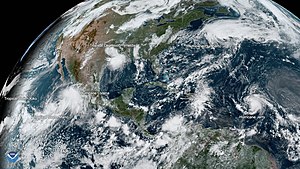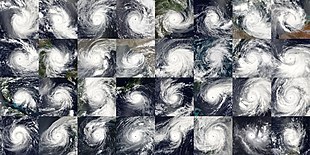Our website is made possible by displaying online advertisements to our visitors.
Please consider supporting us by disabling your ad blocker.
Tropical cyclones in 2019
This article needs additional citations for verification. (December 2020) |
| Tropical cyclones in 2019 | |
|---|---|
 Year summary map | |
| Year boundaries | |
| First system | Mona |
| Formed | December 31, 2018 |
| Last system | Sarai |
| Dissipated | January 2, 2020 |
| Strongest system | |
| Name | Halong |
| Lowest pressure | 905 mbar (hPa); 26.72 inHg |
| Longest lasting system | |
| Name | Oma |
| Duration | 15 days |
| Year statistics | |
| Total systems | 142 |
| Named systems | 100 |
| Total fatalities | 2,500 total |
| Total damage | > $67.647 billion (2019 USD) |


During 2019, tropical cyclones formed within seven different tropical cyclone basins, located within various parts of the Atlantic, Pacific and Indian Oceans. During the year,a total of 142 systems formed, with 100 of these developing further and being named by the responsible warning centre. The strongest tropical cyclone of the year was Typhoon Halong, with a minimum barometric pressure of 905 hPa (26.72 inHg). Cyclone Idai became the deadliest tropical cyclone of the year, after killing at least 1,303 people in Mozambique, Malawi, Zimbabwe, and Madagascar. The costliest tropical cyclone of the year was Typhoon Hagibis, which caused more than $15 billion in damage after striking Japan.
Similar to the previous year, 2019 was above average in terms of the number of storms. The most active basin of the year was the Western Pacific, which documented 29 named systems. The Eastern Pacific had an average season, although many of the storms were rather weak and short-lived, therefore the number of hurricanes was the least since 2010. The North Atlantic hurricane season experienced an above average number of tropical storms, numbering 18, though most were rather weak and short-lived, especially late in the season. In the North Indian Ocean basin it was extremely active, breaking many records. This included Cyclone Kyarr, the second-strongest Arabian Sea Cyclone on record and one of the strongest cyclone ever in the North Indian Ocean. Activity across the southern hemisphere's three basins – South-West Indian, Australian, and South Pacific – was fairly significant, with the regions recording 25 named storms altogether, with the most intense Southern Hemisphere cyclone of the year, Cyclone Ambali from the Southwest Indian Ocean basin peaking with a central pressure of 930 hPa (27.46 inHg). Eight Category 5 tropical cyclones formed in 2019. The accumulated cyclone energy (ACE) index for the 2019 (seven basins combined), as calculated by Colorado State University (CSU) was 854.8 units.
Previous Page Next Page


